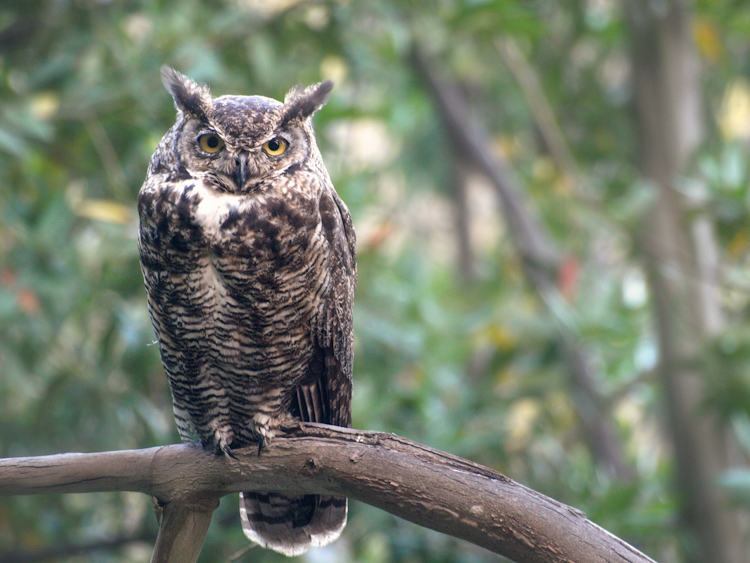They are eastern gods — they meditate.
(Yes they are.)
“The Owls” by Charles Baudelaire
(translated by Edna St. Vincent Millay)
The owls that roost in the black yew
Along one limb in solemn state,
And with a red eye look you through,
Are eastern gods; they meditate.No feather stirs on them, not one,
Until that melancholy hour
When night, supplanting the weak sun,
Resumes her interrupted power.Their attitude instructs the wise
To shun all action, all surprise.
Suppose there passed a lovely face —
Who even longs to follow it,
Must feel for ever the disgrace
Of having all but moved a bit.
This is a Great-horned Owl photographed just off a Berkeley hiking trail. She was observing us without anyone observing her … until Hugh and I caught the anomalous shape in the tree as we walked by. We didn’t want to draw attention to her on a popular hiking route, so I snapped just two photos then moved on.
[Edited to add 2/21/20: In the years since, I’ve learned a bit more about signs of stress in owls. I’m not sure if this owl is exhibiting any of them — looking at the bristles around the owl’s beak, for instance. If you know, I will add those notes or disclaimers to this post so as to educate others who might land here. These days, I’m even more careful now if I encounter owls, to look for changes in their physiology that could indicate a stress response. Owl sightings often bring out throngs of photographers, so I’m careful not to divulge locations nor contribute to the harassment.]
This is great, informative piece on this subject: Signs of Stress in Owls. If you photograph, observe, or plan to photograph owls, please take the time to read this post.
Great-horned Owls exhibit reverse sexual dimorphism, meaning the female is larger than the male. That distinction is beautifully photographed in this post by fellow blogger Ron Dudley. I don’t think it’s possible to tell the sex without both male and female in the frame, but if it is, I’d love to know.


Great shot Ingrid! Eastern and Western Gods they are, the tigers of the sky. Fascinating birds gliding on those quiet wings. I usually see them a bit closer to the trunk during the day or hidden by branches and leaves. Nice find!
Thanks, Larry. Tigers of the sky, yes, what great imagery. The silence of their flight might be what captivates me most. In this same area years prior, the first time we ever hiked it, Hugh and I had an owl barely graze the air as it swooped over us at dusk (I’m sure many have had the experience). Athough it was so fast and quiet, we saw white, meaning it was most likely a Barn Owl. I’m not sure how close he came to our heads (it felt close) but it put me in the paws, for a moment, of a vole or mouse who literally does not see what’s coming.
Ingrid, I loved the fact that you avoided bringing attention to the bird. That would have been my instinct too – particularly for an owl, and in especially in that situation.
I think you’re right – the sexes can’t reliably be distinguished. Here’s what BNA has to say on the subject: “Both sexes generally similar in coloration patterns. No appreciable seasonal, sex or age differences in plumage”.
Ron, I break the tripod rule too often for the good of my own photographs because I prefer stealth, handheld mode where I can get away with it (urban). It’s a bit different in wild areas where you have other photographers who kind of understand the rules — well, sometimes (as we know). On this hike, as I shot the GHO, one person stopped to ask about it, then continued on his run. I realized there would be countless other people coming along who’d also inquire and that’s when we quickly packed it up. I agree with you about owls. I’m as enmeshed in fascination with them as anyone, but I don’t ever give out locations, selfish though that seems to some. (I saw another Snowy Owl today, but in a very sedate, residential setting where I don’t think the owl was disturbed. I’ll post a few shots if they turned out.)
[…] Great Horned Owl in Berkeley California – Photo of … – The Free Quark Photo of a Great-horned Owl perched on a branch in Berkeley, California. Great-horned Owls exhibit reverse sexual dimorphism, meaning the female is larger than the male. That distinction is beautifully photographed in . […]